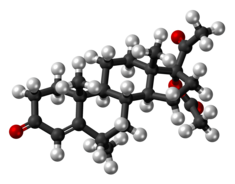 | |
 | |
| Clinical data | |
|---|---|
| Pronunciation | /mɛˌdrɒksiproʊˈdʒɛstəroʊn ˈæsɪteɪt/ me-DROKS-ee-proh-JES-tər-ohn ASS-i-tayt[1] |
| Trade names | Depo-Provera, others |
| Other names | MPA; DMPA; Methylhydroxy |
| AHFS/Drugs.com | Monograph |
| MedlinePlus | a604039 |
| Pregnancy category |
|
| Routes of administration | By mouth, sublingual, intramuscular injection, subcutaneous injection |
| Drug class | Progestogen; Progestin; Progestogen ester; Antigonadotropin; Steroidal antiandrogen |
| ATC code | |
| Legal status | |
| Legal status | |
| Pharmacokinetic data | |
| Bioavailability | By mouth: ~100%[4][5] |
| Protein binding | 88% (to albumin)[5] |
| Metabolism | Liver (hydroxylation (CYP3A4), reduction, conjugation)[6][4][9] |
| Elimination half-life | By mouth: 12–33 hours[6][4] IM (aq. susp.): ~50 days[7] SC (aq. susp.): ~40 days[8] |
| Excretion | Urine (as conjugates)[6] |
| Identifiers | |
| |
| CAS Number | |
| PubChem CID | |
| IUPHAR/BPS | |
| DrugBank | |
| ChemSpider | |
| UNII | |
| KEGG | |
| ChEBI | |
| ChEMBL | |
| CompTox Dashboard (EPA) | |
| ECHA InfoCard | 100.000.689 |
| Chemical and physical data | |
| Formula | C24H34O4 |
| Molar mass | 386.532 g·mol−1 |
| 3D model (JSmol) | |
| Melting point | 207 to 209 °C (405 to 408 °F) |
| |
| |
| (verify) | |
Medroxyprogesterone acetate (MPA), also known as depot medroxyprogesterone acetate (DMPA) in injectable form and sold under the brand name Depo-Provera among others, is a hormonal medication of the progestin type.[10][4] It is used as a method of birth control and as a part of menopausal hormone therapy.[10][4] It is also used to treat endometriosis, abnormal uterine bleeding, paraphilia, and certain types of cancer.[10] The medication is available both alone and in combination with an estrogen.[11][12] It is taken by mouth, used under the tongue, or by injection into a muscle or fat.[10]
Common side effects include menstrual disturbances such as absence of periods, abdominal pain, and headaches.[10] More serious side effects include bone loss, blood clots, allergic reactions, and liver problems.[10] Use is not recommended during pregnancy as it may harm the baby.[10] MPA is an artificial progestogen, and as such activates the progesterone receptor, the biological target of progesterone.[4] It also has androgenic activity and weak glucocorticoid activity. Due to its progestogenic activity, MPA decreases the body's release of gonadotropins and can suppress sex hormone levels.[13] It works as a form of birth control by preventing ovulation.[10]
MPA was discovered in 1956 and was introduced for medical use in the United States in 1959.[14][15][10] It is on the World Health Organization's List of Essential Medicines.[16] MPA is the most widely used progestin in menopausal hormone therapy and in progestogen-only birth control.[17][18] DMPA is approved for use as a form of long-acting birth control in more than 100 countries.[19][20] In 2021, it was the 238th most commonly prescribed medication in the United States, with more than 1 million prescriptions.[21][22]
- ^ "Medroxyprogesterone Uses, Dosage & Side Effects".
- ^ "FDA-sourced list of all drugs with black box warnings (Use Download Full Results and View Query links.)". nctr-crs.fda.gov. FDA. Retrieved 22 October 2023.
- ^ "Product monograph brand safety updates". Health Canada. February 2024. Retrieved 24 March 2024.
- ^ a b c d e f Kuhl H (2005). "Pharmacology of estrogens and progestogens: influence of different routes of administration" (PDF). Climacteric. 8 (Suppl 1): 3–63. doi:10.1080/13697130500148875. PMID 16112947. S2CID 24616324.
- ^ a b Schindler AE, Campagnoli C, Druckmann R, Huber J, Pasqualini JR, Schweppe KW, Thijssen JH (2008). "Classification and pharmacology of progestins". Maturitas. 61 (1–2): 171–80. doi:10.1016/j.maturitas.2008.11.013. PMID 19434889.
- ^ a b c "Provera" (PDF). FDA. 2015. Archived from the original (PDF) on 11 February 2017. Retrieved 31 March 2018.
- ^ "Depo_Provera" (PDF). FDA. 2016. Retrieved 31 March 2018.
- ^ "depo-subQ Provera" (PDF). FDA. 2017. Retrieved 31 March 2018.
- ^ Cite error: The named reference
pmid26291834was invoked but never defined (see the help page). - ^ a b c d e f g h i "Medroxyprogesterone Acetate". The American Society of Health-System Pharmacists. Archived from the original on 24 December 2016. Retrieved 8 December 2016.
- ^ Cite error: The named reference
Drugs.comwas invoked but never defined (see the help page). - ^ Cite error: The named reference
Martindalewas invoked but never defined (see the help page). - ^ Cite error: The named reference
Genazzani1993was invoked but never defined (see the help page). - ^ Roberts SM (7 May 2013). Introduction to Biological and Small Molecule Drug Research and Development: Chapter 12. Hormone replacement therapy. Elsevier Science. pp. 9–. ISBN 978-0-12-806202-9.
[...] medroxyprogesterone acetate, also known as Provera (discovered simultaneously by Searle and Upjohn in 1956) [..]
- ^ Sneader W (2005). "Chapter 18: Hormone analogs". Drug discovery: a history. New York: Wiley. p. 204. ISBN 0-471-89980-1.
- ^ World Health Organization (2019). World Health Organization model list of essential medicines: 21st list 2019. Geneva: World Health Organization. hdl:10665/325771. WHO/MVP/EMP/IAU/2019.06. License: CC BY-NC-SA 3.0 IGO.
- ^ Meikle AW (1 June 1999). Hormone Replacement Therapy. Springer Science & Business Media. pp. 383–. ISBN 978-1-59259-700-0.
- ^ Special Programme of Research, Development, and Research Training in Human Reproduction (World Health Organization), World Health Organization (2002). Research on Reproductive Health at WHO: Biennial Report 2000-2001. World Health Organization. pp. 17–. ISBN 978-92-4-156208-9.
{{cite book}}: CS1 maint: multiple names: authors list (link) - ^ Cite error: The named reference
BagadePawar2014cwas invoked but never defined (see the help page). - ^ Cite error: The named reference
Gunasheela2011was invoked but never defined (see the help page). - ^ "The Top 300 of 2021". ClinCalc. Archived from the original on 15 January 2024. Retrieved 14 January 2024.
- ^ "Medroxyprogesterone - Drug Usage Statistics". ClinCalc. Retrieved 14 January 2024.